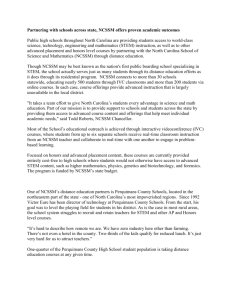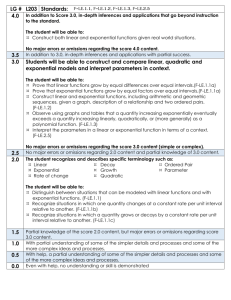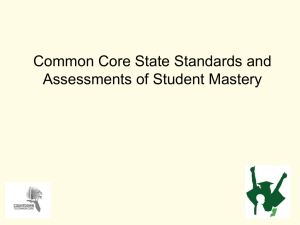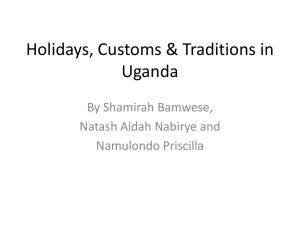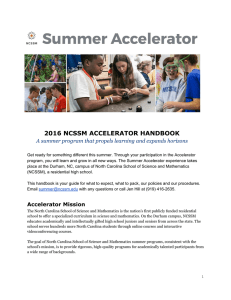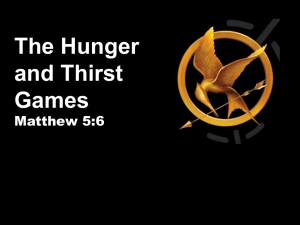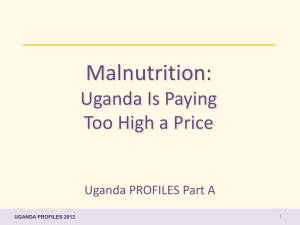NCCTM Exponential Growth - North Carolina School of Science
advertisement
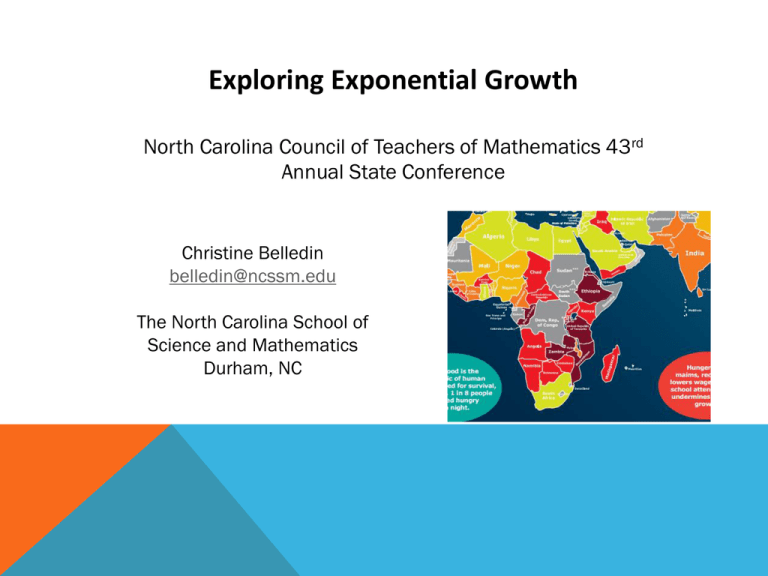
Exploring Exponential Growth North Carolina Council of Teachers of Mathematics 43rd Annual State Conference Christine Belledin belledin@ncssm.edu The North Carolina School of Science and Mathematics Durham, NC GOALS FOR THE SESSION • We will show how to use data about grain production and population growth in Uganda to compare linear and exponential growth. • We will show how students can understand the meaning of the constants in an exponential function by relating them back to our context. WHERE THIS IDEA COMES FROM… Reverend Thomas Robert Malthus (1766-1834) British cleric and scholar Known for theories about population growth and change. MALTHUSIAN THEORY FACTS ABOUT HUNGER • Total number of children that die each year from hunger: 1.5 million • Percent of world population considered to be starving: 33% • Number of people who will die from hunger today: 20,866 • Number of people who will die of hunger this year: 7,615,360 Grain production for Uganda in 1000’s of tons Year Grains 1998 2085 1999 2178 2000 2112 2001 2309 2002 2368 2003 2508 2004 2274 2005 2459 2006 2667 2007 2631 BELOW IS GRAPH OF THE DATA We would like to build a linear model for the data set. Grains Grain Produced in 1000's of tons 3000 2500 2000 1500 1000 500 0 0 2 4 6 8 Years Since 1995 10 12 14 LINEAR FUNCTION Grains 3000 Y=61.255x+1899.7 2500 2000 y = 61.255x + 1899.7 1500 1000 500 0 0 2 4 6 8 10 12 14 USING OUR LINEAR MODEL • Interpret the slope and intercept in context. • Make predictions about future food production. • Later compare growth of food production to population growth. POPULATION GROWTH FOR UGANDA To the right is a table of Uganda’s population in millions in the years from 1995 to 2009. Year 1995 1996 1997 1998 1999 2000 2001 2002 2003 2004 2005 2006 2007 2008 2009 Population 20.7 21.2 21.9 22.5 23.2 24.0 24.7 25.5 26.3 27.2 28.2 29.2 30.3 31.4 32.4 CREATE A SCATTER PLOT OF THE DATA Population of Uganda 35 Popuation in millions 30 25 20 15 10 5 0 0 2 4 6 8 10 Years Since 1995 12 14 16 CONSIDER VARIOUS MODELS • Linear • Quadratic • Exponential FROM PREVIOUS WORK We know • Linear growth is governed by constant differences. • Exponential growth is governed by constant ratios. Let’s use this knowledge to find a model for population... ANOTHER OPTION: RE-EXPRESSING THE DATA We can re-express the data using inverse functions. If we think the appropriate model is an exponential function, let’s use the logarithm to “straighten” the data. Consider the ordered pairs (time, ln(population)). Look at the graph of this re-expressed data. COMPARING GROWTH Can we find ways to compare growth of food production to population? EX. 2: FOOD PRODUCTION VS. POPULATION GROWTH 1. The population of a country is initially 2 million people and is increasing at 4% per year. The country's annual food supply is initially adequate for 4 million people and is increasing at a constant rate adequate for an additional 0.5 million people per year. a. Based on these assumptions, in approximately what year will this country rst experience shortages of food? Taken from Illustrative Mathematics FOOD SUPPLY VS. POPULATION CONTINUED… b. If the country doubled its initial food supply and maintained a constant rate of increase in the supply adequate for an additional 0.5 million people per year, would shortages still occur? In approximately which year? c. If the country doubled the rate at which its food supply increases, in addition to doubling its initial food supply, would shortages still occur? WHY ARE THESE PROBLEMS SO POWERFUL? • Students see that mathematics can help us understand important real-life issues • Students have the chance to create mathematical models. • We can help students make sense of the constants in the models. (Interpret constants in context.) • Students build tools to help them distinguish between different types of growth based on mathematical principles. CCSS CONTENT STANDARDS HSF-LE.A.1 Distinguish between situations that can be modeled with linear functions and with exponential functions. HSF-LE.A.1a Prove that linear functions grow by equal differences over equal intervals, and that exponential functions grow by equal factors over equal intervals. HSF-LE.A.1b Recognize situations in which one quantity changes at a constant rate per unit interval relative to another. HSF-LE.A.1c Recognize situations in which a quantity grows or decays by a constant percent rate per unit interval relative to another. HSF-LE.A.2 Construct linear and exponential functions, including arithmetic and geometric sequences, given a graph, a description of a relationship, or two input-output pairs (include leading these from a table). . MORE CCSS CONTENT STANDARDS S.ID.6 Represent data on two quantitative variables on a scatter plot, and describe how the variables are related. b. Informally assess the fit of a function by plotting and analyzing residuals. Represent data on two quantitative variables on a scatterplot, and describe how the variables are related. c. Fit a linear function for a scatter plot that suggests a linear association. S.ID.7 Interpret the slope (rate of change) and the intercept (constant term) of a linear model in the context of the data. CCSS MATHEMATICAL PRACTICES 1. 2. 3. 4. 5. 6. 7. 8. Make sense of problems and persevere in solving them Reason abstractly and quantitatively Construct viable arguments and critique the reasoning of others Model with mathematics Use appropriate tools strategically Attend to precision Look for and make use of structure Look for and express regularity in repeated reasoning RESOURCES FOR TEACHERS • NCSSM Algebra 2 and Advanced Functions websites www.dlt.ncssm.edu/AFM http://www.dlt.ncssm.edu/algebra/ See Linear Data and Exponential Functions • Link to NEW Recursion Materials http://www.dlt.ncssm.edu/stem/content/lesson-1-introduction-recursion • NCSSM CCSS Webinar: Session 1: Using Recursion to Explore Real-World Problems http://www.dlt.ncssm.edu/stem/using-recursion-explore-real-world-problems MORE RESOURCES • Illustrative Mathematics http://www.illustrativemathematics.org/standards/hs Tasks that illustrate part F-LE.A.1.a F-LE Equal Differences over Equal Intervals 1 F-LE Equal Differences over Equal Intervals 2 F-LE Equal Factors over Equal Intervals • The Essential Exponential by Al Bartlett http://www.albartlett.org/books/essential_exponential.html LINKS TO DATA AND INFORMATION Gapminder http://www.gapminder.org/ World Hunger Map Link http://www.wfp.org/hunger/downloadmap Link to Data for Uganda http://faostat.fao.org/site/609/DesktopDefault.aspx?PageID=609#ancor My Contact Information: Christine Belledin – NC School of Science and Mathematics belledin@ncssm.edu For copies of the presentation and other materials, please visit http://courses.ncssm.edu/math/talks/conferences/ after Monday, November 4. Thank you for attending!

